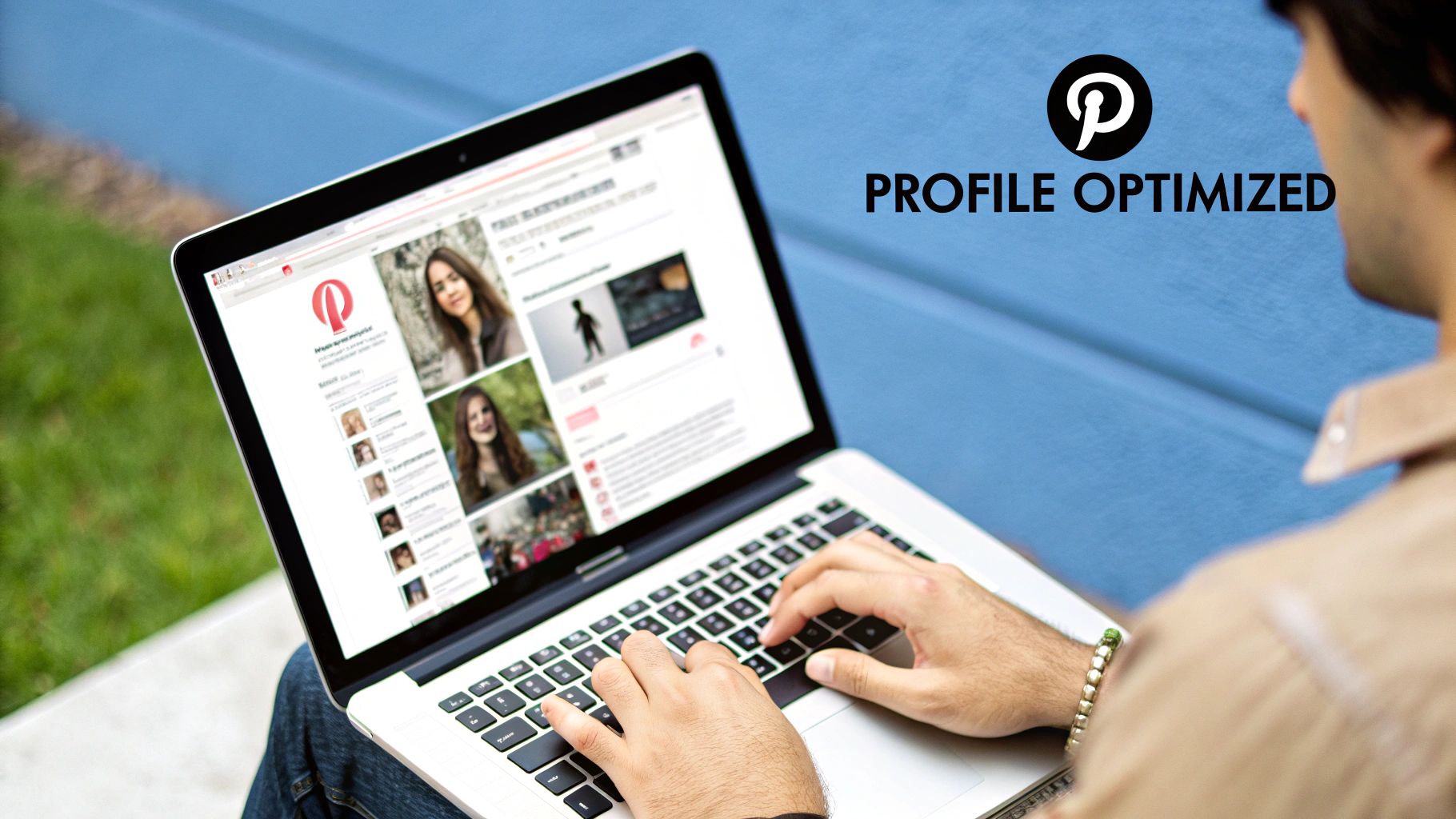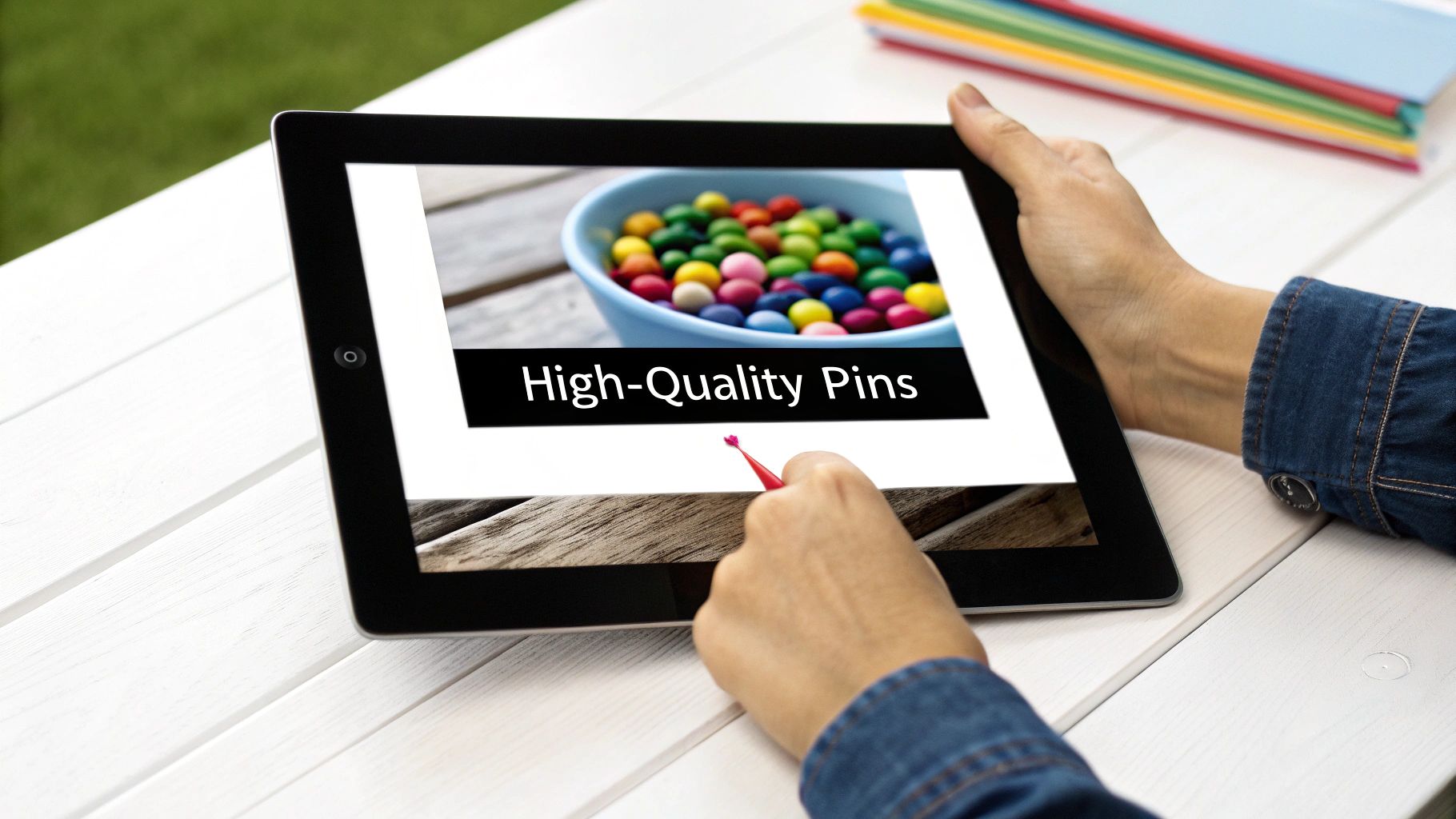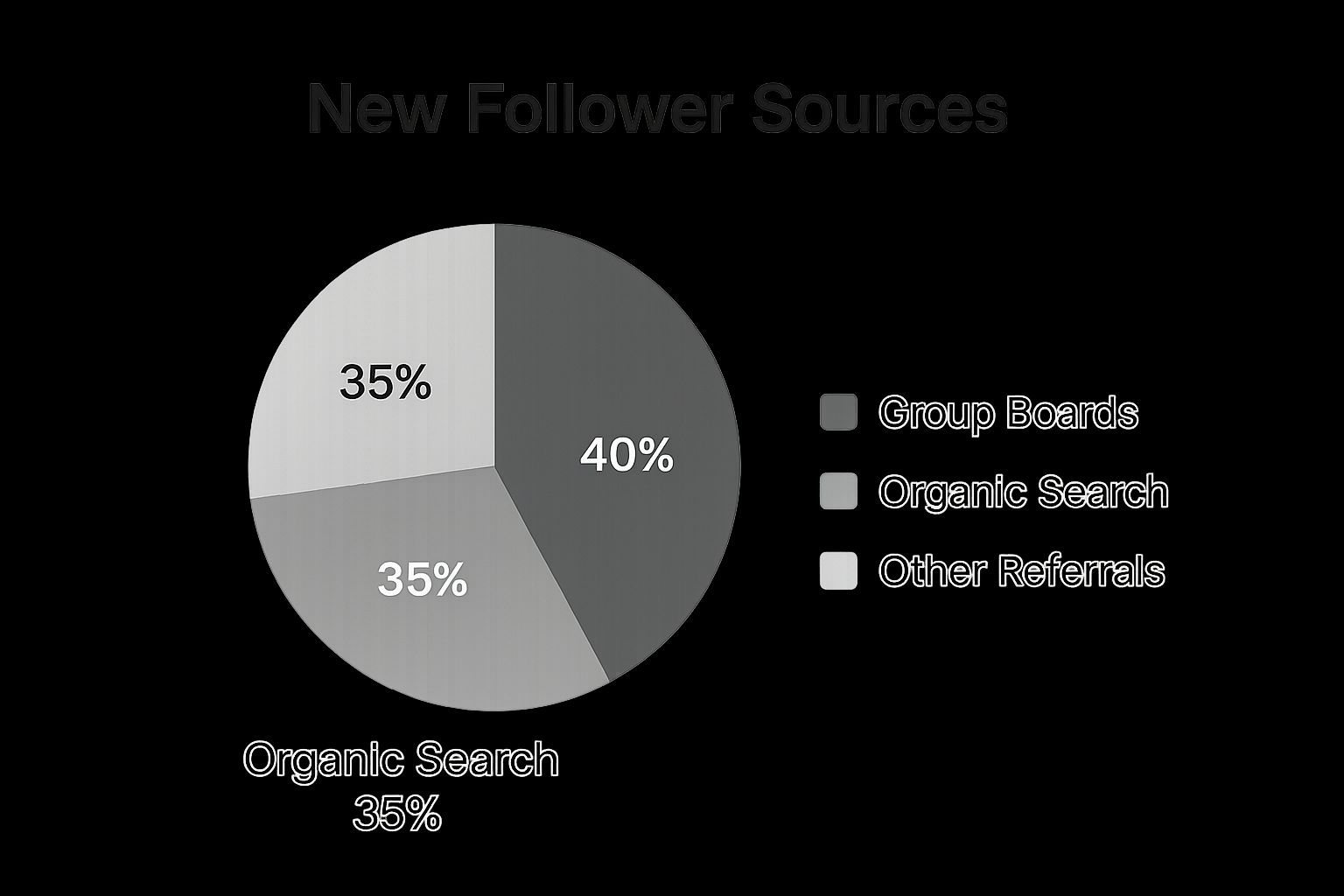How to Gain Pinterest Followers: Proven Strategies to Grow Fast
Before you can even start thinking about racking up followers, you need to get your house in order. A solid Pinterest foundation is non-negotiable. It all starts with a keyword-rich business profile and a steady stream of high-quality Pins that your ideal audience is actually looking for.
I've seen so many people treat Pinterest like just another social network. That's a mistake. It’s a visual search engine, and if you want to be discovered, you have to play by its rules.
Build a Follow-Worthy Pinterest Foundation

Let's be real: you have to give people a compelling reason to click that "Follow" button. Your Pinterest profile is like the front door to your brand. A weak first impression will have potential followers bouncing before they even see your brilliant content. The goal isn't to just check boxes; it's to create a magnetic, professional presence that pulls people in.
First things first: you absolutely must have a Pinterest Business account. If you're still on a personal profile, switching is free, easy, and critical for growth. Doing so unlocks the good stuff, like Pinterest Analytics and the ability to claim your website.
Craft a Keyword-Rich Profile
Your profile is prime SEO real estate. Every single element needs to work together to tell both users and the Pinterest algorithm exactly what you're all about.
Organize Your Boards for Discovery
Think of your boards as the aisles in your brand's store. A jumbled mess of random, unfocused boards just looks sloppy and confuses potential followers. What you want is a clean, organized structure with specific, keyword-optimized board titles.
Put yourself in your audience's shoes. If you're a home decor blogger, a single, massive "Home Decor" board is a missed opportunity. Instead, get specific with niche boards like:
This targeted approach not only makes your profile a breeze to navigate but also helps your content rank for a much wider range of search terms. And don't forget to give each board a clear, keyword-rich description explaining exactly what people will find inside.
Claim Your Website
This is a critical step that so many creators skip, and it's a huge mistake. Claiming your website is how you officially link your site to your Pinterest account, and it comes with some serious perks. For starters, it adds your profile picture and a "Follow" button to any Pin that comes from your site, which screams authority.
More importantly, it unlocks detailed analytics for Pins from your domain. This is gold. You can see precisely which content is driving clicks and engagement, which is essential for refining your strategy over time. The process is pretty painless and usually just involves adding a meta tag to your website's header.
Think of it this way: an unclaimed website is like an anonymous tip, but a claimed website is a verified source. Pinterest and its users trust verified sources more. Getting this done means your profile is now a cohesive brand hub, perfectly primed to attract the right audience.
Create Pins That Stop the Scroll

Let's be honest: on Pinterest, your Pins are your currency. A polished profile gets you in the door, but it's your visual content that convinces someone to actually stick around and hit that "Follow" button. The goal is to create Pins that literally stop people mid-scroll, making them pause, click, and save.
This isn't just about finding a pretty picture and slapping it up. A truly effective Pin is a deliberate mix of art and science, built to grab attention and communicate value in a split second. Let's break down what it takes to turn a simple image into a follower-generating machine.
Master the Anatomy of a Great Pin
After years of working with this platform, I've seen that the most successful Pins all share a few key traits. They are designed for Pinterest's vertical feed and are incredibly easy to understand at a glance. Think of every single Pin as a tiny, compelling advertisement for your content or brand.
Here are the non-negotiable design elements you have to get right:
Choose the Right Pin Format for Your Goal
Pinterest gives you a few different tools in your toolbox. Knowing which Pin format to use—and when—is what separates a scattered approach from a strategic one that actually grows your following. Don't just stick to one; mix it up to keep your content fresh and maximize your reach.
Standard Pins: These are the bread and butter of Pinterest. A static image that links to an external URL, like your latest blog post or a product page. These are your go-to for driving traffic.
Video Pins: These short clips (usually 6-15 seconds) are fantastic for grabbing attention because they autoplay in the feed. Use them for quick tutorials, behind-the-scenes content, or to show a product in action.
Idea Pins: Think of these as multi-page, story-like Pins that live on Pinterest (they don't link out). They are designed for storytelling and are heavily favored by the algorithm for building an audience directly on the platform. Use them for step-by-step guides and lists. Because they encourage follows, they are an absolute powerhouse for follower growth.
Write Compelling, Keyword-Optimized Descriptions
While the visual is what stops the scroll, the description is what gets your Pin discovered in the first place. This is where all that keyword research you did pays off. A well-written description tells both users and the Pinterest algorithm what your Pin is all about.
Weave your primary and secondary keywords into a few natural-sounding sentences. Tell the user exactly what they'll get when they click. For more detail, you can check out our complete guide on how to optimize Pinterest Pins for maximum visibility.
Here's how this looks in practice across different niches:
When you consistently apply these principles, you shift from just randomly pinning things to strategically creating assets designed for discovery. That is the true foundation for attracting a loyal audience that can't wait to see what you'll share next.
Develop Your Pinterest Content Strategy
Pinning content at random is like throwing darts in the dark. You might hit the board eventually, but you'll never hit the bullseye. If you're serious about gaining Pinterest followers, it's time to shift from being a casual pinner to a focused content strategist. This means every single Pin you create serves a purpose.

A solid plan turns your Pinterest efforts from a time-consuming chore into a predictable engine for attracting your ideal audience. Let’s get that engine built.
Uncover What Your Audience Wants with Keyword Research
Before you even think about designing a Pin, you need to get inside your audience's head. Guessing what they want is a complete waste of time. Luckily, Pinterest has some fantastic built-in tools that let you see exactly what people are searching for.
Your best friend here is the Pinterest search bar. Start typing a broad term related to your niche, like "healthy recipes." Almost instantly, Pinterest will show you a dropdown list of popular, more specific searches real users are making, like "healthy recipes for weight loss" or "healthy recipes for picky eaters." These suggestions are pure gold.
Next, you'll want to dig into Pinterest Trends. This tool is amazing for spotting seasonal patterns and up-and-coming trends by showing you the popularity of search terms over time. For instance, you’d see that searches for "fall home decor" begin to spike every August. That’s your cue to start creating that content well ahead of time, not in the middle of October when you've missed the wave.
Establish Your Core Content Pillars
Once you've got a solid list of keywords, it's time to bring some order to the chaos. You can't be everything to everyone, so you need to define your core areas of expertise. We call these content pillars—the 3-5 main topics your account will be known for.
These pillars should be broad enough to spark plenty of ideas but specific enough to attract a loyal, niche audience. Grouping your keywords under these pillars gives your strategy focus and structure.
A personal finance blogger, for example, might land on these pillars:
This approach ensures you're consistently creating relevant content that reinforces your authority. It gives people a clear, compelling reason to follow you because they know exactly what kind of value you'll deliver.
Structure Your Boards for Maximum Impact
Think of your Pinterest boards as more than just digital folders. They are curated collections designed to attract different segments of your audience. A smart board structure is absolutely essential for getting discovered.
The key is to use a strategic mix of broad and niche boards.
Broad Interest Boards act like magnets at the top of your funnel, pulling in users with more general interests. For a food blogger, this might be a board simply titled "Easy Dinner Recipes."
Hyper-Niche Boards are where you really shine. They cater to users who know exactly what they want. That same food blogger could create niche boards like "30-Minute Vegan Meals," "Keto-Friendly Desserts," or "Air Fryer Chicken Recipes."
Here’s a quick breakdown of why this one-two punch works so well:
A non-negotiable tip: Always, always place your branded board—the one featuring only your content—right at the very top of your profile. From there, organize the rest logically. Make sure every board has a keyword-optimized title and a detailed description that tells people exactly what they'll find. This thoughtful organization transforms your profile from a random collection of Pins into an invaluable resource people will want to follow.
Use Community Engagement to Fuel Growth
Look, creating incredible content is a huge part of the puzzle, but it’s only half the story. If you're just pinning into the void, you’re leaving one of the most powerful growth strategies on the table. Pinterest isn't just a visual search engine—it's a living, breathing community. Diving in and participating is how you signal to both people and the algorithm that you're a valuable member, and that’s what really gets the growth engine humming.
This isn’t about dropping spammy, generic comments. It's about making real connections and showing up where your ideal followers are already hanging out. Think of it as joining the conversation, not just shouting from the sidelines.
Harness the Power of Group Boards
Group boards are essentially collaborative spaces where different creators can add Pins to one shared board. Getting into the right ones is like getting a backstage pass to someone else’s well-established audience. When you share a Pin to a board with thousands of followers, your content gets an instant visibility boost to a network far larger than your own.
Finding the right boards is everything. You'll want to focus on ones that are:
Once you’re in, be the contributor you'd want to see. Share your absolute best Pins, but don’t forget to repin great content from other members, too. That kind of reciprocity is the glue that holds a good group board together and makes you a valued part of it.
Create a Routine for Genuine Interaction
Beyond group boards, a simple daily habit of genuine engagement can make a world of difference. This goes deeper than just mindlessly repinning things to your own boards. It’s about becoming a real participant in your niche.
Try setting aside just 10-15 minutes a day to browse your smart feed and interact. When you see a great Pin, leave a thoughtful comment. Instead of a lazy "Nice Pin!", say something that shows you actually looked at it, like, "This is a brilliant use of vertical storage for a small living room! That shelf idea is genius."
This small effort accomplishes two critical things. First, it puts your name and profile picture in front of other active people in your space, sparking their curiosity to check you out. Second, it tells the Pinterest algorithm that you're an engaged user, which can help give your own Pins a little extra push.
The data below shows just how much community-driven sources can fuel new follower growth.

As you can see, active participation, like contributing to Group Boards, can be a major source of new followers—sometimes even more impactful than organic search.
Think Globally to Grow Your Audience
Understanding the core demographics of Pinterest's user base is key to creating content that resonates and attracts followers from its largest and most active segments.
Pinterest Global Audience Snapshot
With 80% of Pinners now located outside the United States, your next wave of followers might be searching in a different language or have different cultural touchstones. Younger adults aged 18-34 are also driving the platform's global expansion.
To tap into this massive audience, start creating Pins with universal visual appeal. Use clear, concise text overlays that are easy to understand, no matter where someone is from.
Ultimately, community engagement is about building relationships. It humanizes your brand and transforms your account from a simple content library into a valuable hub. When you do it right, getting a follow feels less like a transaction and more like joining an exclusive club. To get even more specific with your engagement, understanding how hashtags work on Pinterest can help you tap into trending conversations within the community.